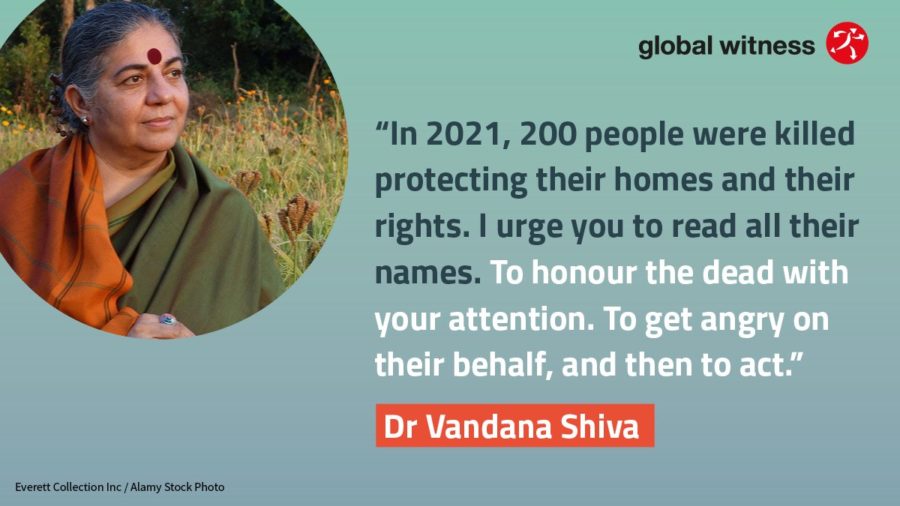
I could tell you that, around the world, three people are killed every week while trying to protect their land, their environment, from extractive forces. I could tell you that this has been going on for decades, with the numbers killed in recent years hitting over 200 each year. And I could tell you, as this report does, that a further 200 defenders were murdered in the last year alone. But these numbers are not made real until you hear some of the names of those who died.
Marcelo Chaves Ferreira. Sidinei Floriano Da Silva. José Santos López. Each of them a person loved by their family, their community. Jair Adán Roldán Morales. Efrén España. Eric Kibanja Bashekere. Each of them considered expendable for the sake of profit. Regilson Choc Cac. Ursa Bhima. Angel Rivas. Each killed defending not only their own treasured places, but the health of the planet which we all share.
It’s important to picture these victims as the real people they are. It’s easier for me. I have been surrounded by land and environmental defenders all my life, and indeed I am one of them. It started for me in the Garhwal Himalaya in India, where my father was a forest conservator and my mother a farmer. Industrial logging was destroying the ecosystem in which we as humans were intertwined. We knew, intimately, that the value of the Himalayan forest was not to be found in the price of its timber, but in the way its extraordinary, abundant diversity sustains all forms of life – not least our own. And so we put ourselves in the way of the commercial deforesters.
By doing so, we weren’t just putting ourselves in danger. We were confronting a whole viewpoint – a way of seeing nature as something not to be cherished and protected, but to be conquered and subdued. This is a viewpoint with its roots in the Western industrial revolutions of the 19th century, or even further back in the scientific theory of the Western so-called ‘Enlightenment’. It matters that this viewpoint originated in the West. As this report shows, nearly all of the murdered environmental and land defenders are from the Global South, and yet it is not the Global South that reaps the supposed economic ‘rewards’ of all this violence.
Climate activists hold up signs next to portraits of slain Philippine environmental defenders as they take part in climate justice protests on November 06, 2021 in Quezon city, Philippines. Ezra Acayan/Getty Images
The final, saddest truth is that this viewpoint has brought us to the brink of collapse. We are not just in a climate emergency. We are in the foothills of the sixth mass extinction, and these defenders are some of the few people standing in the way. They don’t just deserve protection for basic moral reasons. The future of our species, and our planet, depends on it.
That’s why it’s so important to support the call, made in this report by Global Witness, for real protections to be afforded those on the frontline of this ecological and humanitarian catastrophe. These are the people who understand, at the most fundamental level, how the fate of humanity is entwined in the fate of the natural places they are defending. It’s why they are prepared to risk everything to defend these places. And it’s why they, more than anyone, deserve protection.
That means national and supranational governments committing to report and investigate these murders, and ultimately to serve justice on the culprits. It means governments ensuring protections for defenders, including reporting and investigating their murders as a means to access justice. It means companies ensuring their operations do not cause harm. And of course it means all of us continuing to shine a light on these stories, not just to remember those who have fallen but to continue their urgent work by telling the world exactly why they are dead.
In 2021, 200 people were killed protecting their homes and their rights. I urge you to read all their names. To honour the dead with your attention. To get angry on their behalf, and then to act.
Featuring first-person testimony from defenders on four different continents, the report shows that:
- Between 2012 and 2021, 1733 defenders have been killed trying to protect their land and resources: that’s an average of one defender killed approximately every two days over ten years.
- Over half of the attacks over the 10-year period have taken place in just three countries – Brazil, Colombia, and the Philippines.
- In 2021, 200 land and environmental defenders lost their lives – nearly four people a week. These lethal attacks continue to take place in the context of a wider range of threats against defenders who are being targeted by government, business and other non-state actors with violence, intimidation, smear campaigns and criminalisation. This is happening across every region of the world and in almost every sector.
- Mexico was the country with the highest recorded number of killings in 2021 (54), followed by Colombia (33) and Brazil (26).
- Over three-quarters of the attacks recorded in 2021 took place in Latin America. In Brazil, Peru and Venezuela, 78% of attacks took place in the Amazon.
- The research has also highlighted that Indigenous communities in particular face a disproportionate level of attacks – nearly 40% – even though they make up only 5% of the world’s population.
